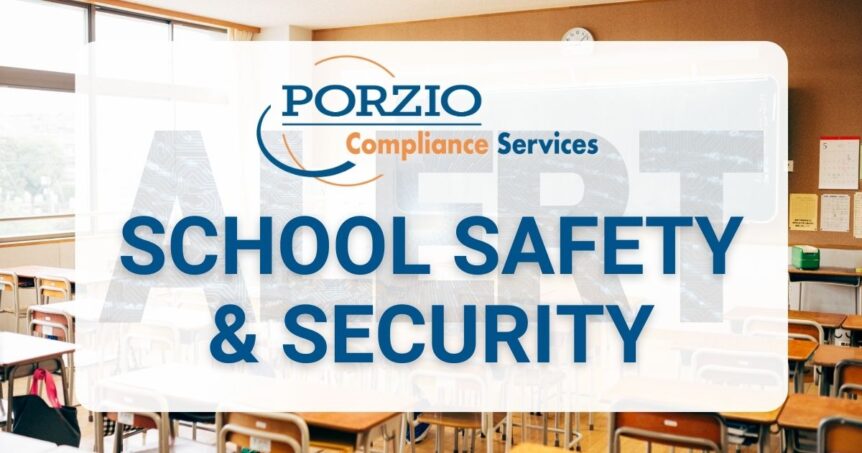As plans for proms, award ceremonies, graduations, and other year-end activities are finalized, the school year is officially winding down.
In the weeks ahead, students, teachers, and other staff members will be off for a much-needed break. School administrators, maintenance, and, hopefully, some security staff will remain in empty or sparsely populated school buildings to begin the task of cleaning, planning, and preparing for the next school year. While school administrators plan the school curriculum and calendar and maintenance staff coordinate facility projects and upgrades, the important issues of safety and security must not be neglected.
Summer break is a great time for schools to give essential attention to security issues and planning to ensure a safe return when school reopens.
Assess Security to Identify Vulnerabilities
Reduced staff and student presence during the summer months provide a great opportunity to conduct physical security assessments, risk and vulnerability assessments, and thorough reviews of School Emergency Operations Plans (EOPs). Physical security assessments should be performed by knowledgeable individuals with training and experience in physical security as well as Crime Prevention Through Environmental Design (CPTED) concepts specific to the school environment. Assessment applications and checklists can be used as a a starting point for analysis,, and schools may solicit the assistance of local law enforcement agencies to aid in this process. While these templates and checklists supply basic generic information, they are not a substitute for a comprehensive, school-specific assessment and review of security strategies, policies, procedures, and school climate considerations. For this reason, school security consultants are a popular option, particularly when local expertise is not available. Security consultants can furnish an unbiased view of vulnerabilities and make recommendations based on industry standards and best practices, along with prioritized action plans to mitigate vulnerabilities. When considering a security firm or consultant, it is vitally important that their experience and references are thoroughly reviewed and properly vetted.
Risk and vulnerability assessments should be reviewed and/ or conducted in collaboration with local emergency managers. While these assessments are not prone to frequent change, your local Office of Emergency Management (OEM) and law enforcement agencies will have the most up-to-date information regarding those issues that may impact your facility and community.
A thorough review of your school EOP should also be undertaken at least annually, and summertime provides an opportunity to do this, unencumbered by the daily tasks that await you in September. This review should include an evaluation and update of emergency plans and procedures as well as names and contact information for those key staff members who will coordinate and facilitate emergency responses. Much like the other assessments, collaboration with both internal and external stakeholders is key to a comprehensive all-hazards EOP. The planning and review of the school EOP should include a districtwide planning team made up of school and community stakeholders. The team should, minimally, include school building administrators and staff, security staff, facilities representatives, and local Police, Fire, EMS, and OEM representatives. Any new initiatives or updates driven by legislation or new regulations must be incorporated into the plans as well. Many states are mandating threat assessment teams, panic alarms, specific plans for individuals with disabilities, and other new requirements to enhance safety for the entire school community. When it comes to mandated safety and security measures, compliance is key.
Before staff and students return, review your punch list of security issues, facility upgrades, and repairs that you were not able to address during the school year. While reasonable efforts are made to address ongoing issues, it is not always possible to get to everything before the end of the school year. As in every industry, schools must prioritize and address the most pressing issues first. Summer is the perfect time to tackle lower-priority items and get them completed before the start of the new school year.
Summer construction and facility upgrades may also impact security systems. Cameras or other security-related technology may be moved, damaged, or otherwise rendered inoperable during construction. Test all systems for proper functionality before school is back in session. This should include camera views, fire, and security alarms, as well as notification and communication systems.
Host Safe Summer Events
The official school calendar may be complete, but in many cases, school facilities serve as community centers and event spaces in the summer. It is important to consider security for summer events, educational programs, sports camps, and community events with the same vigilance as school year security. Summer security must be incorporated into the school EOP, and coordinators and attendees of summer events and programs must be made aware of security procedures and responses. This includes outside organizations that use school facilities. Security and emergency drills should be conducted and, in some states, may be required during the summer months if educational programs are ongoing. This will ensure that building occupants and visitors are aware of safety and security procedures and enable them to respond appropriately if necessary.
Collaboration and Preparation
Recent research on active assailant drills in schools suggests that drills for staff and students should be planned to minimize anxiety and trauma by conducting drills that are age-appropriate and do not employ the use of role players, simulated gunfire, or other methods that make them overly realistic. Realistic training exercises, while not appropriate for students, may be valuable for emergency responders. Summer provides a unique opportunity to collaborate with first responders on security issues and training. Empty school buildings provide a great venue for law enforcement, fire, and EMS personnel to hone their skills with drills and exercises specific to a school environment without children present. Consider offering the use of your facility for active shooter drills, mass casualty exercises, or other emergency response drills. This will enable your local first responders to become familiar with your facilities and provide school leaders with a glimpse of what the emergency response may look like. You may also wish to coordinate tabletop exercises with these community partners to test and review responses in a controlled environment.
Training for Success
Summer is also the optimal time to prepare staff training to be administered prior to the start of the new school year. A review of the school EOP should be conducted in conjunction with other staff in-service training or meetings at back-to-school time. Any additions, changes, or revisions to emergency responses and security procedures must be reviewed and emphasized at this time to ensure that all staff members are aware of the procedures and any changes that may be implemented. It is also important to ensure that new and substitute staff members are thoroughly trained as well. The security chain is only as strong as its weakest link, and new and substitute employees are often overlooked.
For most K-12 school employees and students, summer is the time for rest and relaxation. It is a time to recharge and take a break from the normal routine. School administrators, facilities staff, and security personnel do not have this luxury. Make the best of this time to assess security, plan and prepare your comprehensive all-hazards school EOP, train your staff, and ensure that you are providing a safe and secure experience for your summertime school activities and charting a course for a safe return to school.



